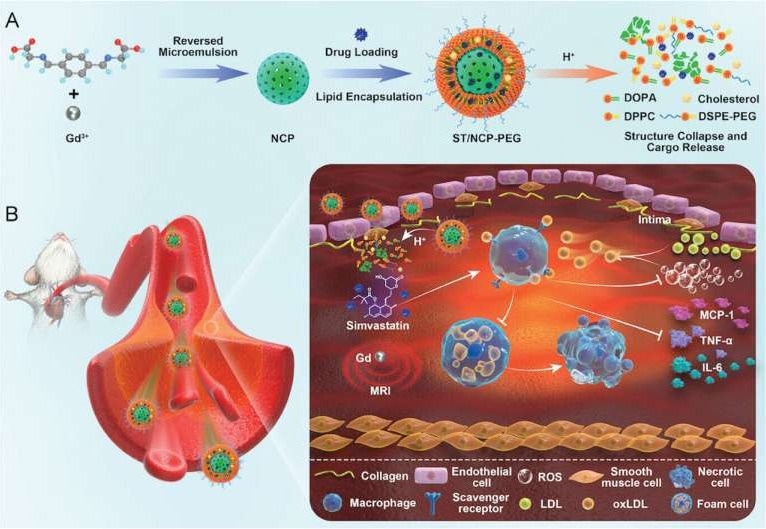Reviewed by Danielle Ellis, B.Sc.Sep 19 2024
A group at NUS Yong Loo Lin School of Medicine (NUS Medicine) has created a nanoparticle technology that provides an efficient and non-invasive way to identify and treat atherosclerosis, according to a study published in Small.
 Schematic illustration of A) fabrication procedure of ST/NCP-PEG and pH-responsive structural collapse under acidic microenvironment. B) the mechanism of pH-responsive and MRI-functional ST/NCP-PEG nanomedicine enabling spontaneous diagnosis and treatment of atherosclerosis. Image Credit: Small (2024). DOI: 10.1002/smll.202401659
Schematic illustration of A) fabrication procedure of ST/NCP-PEG and pH-responsive structural collapse under acidic microenvironment. B) the mechanism of pH-responsive and MRI-functional ST/NCP-PEG nanomedicine enabling spontaneous diagnosis and treatment of atherosclerosis. Image Credit: Small (2024). DOI: 10.1002/smll.202401659
Atherosclerosis is the buildup of plaque in the arteries, which causes them to narrow. It is the leading cause of ischemic heart disease (IHD) and ischemic stroke (IS), both of which contribute significantly to the 17.9 million deaths caused by cardiovascular diseases each year worldwide.
The prevalence of atherosclerosis-related conditions has steadily increased over the last three decades, particularly among younger populations. Lifestyle factors such as unhealthy diets, lack of activity, smoking, and alcohol consumption are all contributing to the increase.
In Singapore, cardiovascular diseases (CVDs) are the leading cause of death, accounting for 31 % of deaths in 2022, with obesity-related heart attacks expected to triple by 2050.
Intravascular ultrasound, coronary angiography, computed tomography angiography, and magnetic resonance imaging (MRI) are all common techniques used to image atherosclerotic plaques. However, these methods have limitations in terms of resolution, invasiveness, and, most importantly, targeted therapy delivery.
- Intravascular ultrasound uses an ultrasound probe on a catheter inside the blood vessel to visualize the artery walls and provide a detailed assessment of the extent and nature of plaques. However, this method is invasive and only applicable to larger blood vessels with limited spatial resolution
- Coronary angiography is a procedure that uses X-ray imaging and an injection of a contrast dye to visualize arteries and detect plaque blockages
- Similar to X-ray coronary angiography, computed tomography angiography employs ionizing radiation and a dye injection to produce more detailed images of blood vessels
- MRI produces the highest-resolution images of the blood vessel and plaque morphology of the four imaging techniques
As of right now, there are no drugs or therapies that can reverse atherosclerosis or dramatically lower the burden of atherosclerotic plaques. Patients at high risk for CVD are typically prescribed anti-platelet agents, such as aspirin, to lower blood pressure and prevent clots from forming at the site of plaques, as well as statins to lower cholesterol. Ace inhibitors and beta-blockers are also used to treat high blood pressure.
This novel theranostic strategy offers a viable substitute for the way that atherosclerosis is currently treated, which is a major advancement in the field of cardiovascular medicine.
Led by Assistant Professor Wang Jiong-Wei from the Department of Surgery, Nanomedicine Translational Research Program at NUS Medicine, and Cardiovascular Research Institute (CVRI), this multidisciplinary study was conducted in collaboration with Associate Professor James Kah from the Department of Biomedical Engineering and Professor Liu Bin from the Department of Chemical and Biomolecular Engineering under the College of Design and Engineering at NUS, and Prof Liu Xiaogang from the Department of Chemistry at the NUS Faculty of Science.
The group created a nanoparticle to tackle prevailing issues; it can identify atherosclerosis, specifically target atherosclerotic plaques and directly administer therapeutic agents to prevent atherosclerosis from progressing in preclinical models.
The nanoparticles, which are made up of a pH-responsive linker and nanoscale coordination polymers (NCP), function by specifically degrading in the acidic environment of atherosclerotic plaques, releasing gadolinium, an MRI contrast agent for real-time imaging of the extent of the plaque, and delivering Simvastatin, a water-insoluble drug with anti-inflammatory and anti-ROS (reactive oxygen species) properties that help stabilize and treat the plaque and lower the risk of cardiovascular events.
The drug can be delivered to the plaques 1000 times more efficiently by the nanoparticles than by the systemic delivery of equivalent doses of simvastatin, which maximizes therapeutic efficacy and reduces systemic side effects.
Overall, our nanoparticles offer a promising novel approach to non-invasive diagnosis, monitoring and targeted treatment of atherosclerosis, a significant advancement that could pave the way for a new era of cardiovascular care.
Wang Jiong-Wei, Assistant Professor, Department of Surgery, Yong Loo Lin School of Medicine, National University of Singapore
As this proof-of-concept study shows, the novel approach has considerable potential, and the team wants to validate its findings further before proceeding to clinical trials.
Journal Reference:
Lin, Y., et. al. (2024) Dual-Function Nanoscale Coordination Polymer Nanoparticles for Targeted Diagnosis and Therapeutic Delivery in Atherosclerosis. Small. doi.org/10.1002/smll.202401659